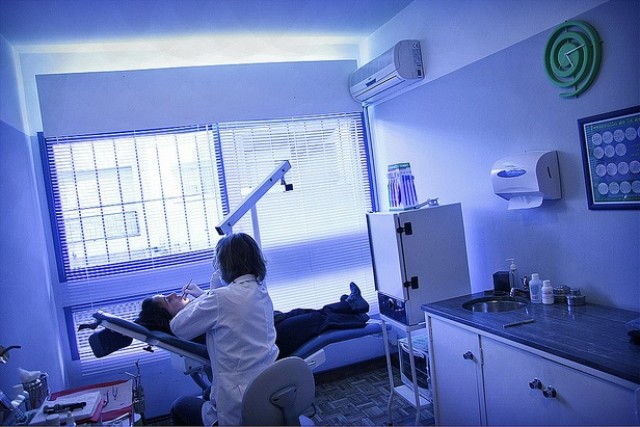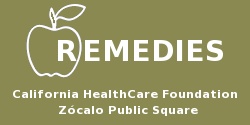
Pam Congdon is the kind of person who has had one cavity her whole life, and most of the time her job, as executive director of the California Association of Oral and Maxillofacial Surgeons, requires unsentimental pragmatism. But her voice catches when she discusses the people who line up–overnight in many cases–for the services of Remote Area Medical, a 27-year-old nonprofit that runs pop-up clinics that are so popular that they are housed in amphitheaters. At the most recent one, in April in Sacramento, RAM California’s team of volunteer dentists and dental hygienists saw 3,000 patients in four days and provided $1 million in services.
“I was expecting to see mostly homeless and indigent people, grungy-looking,” she says. “But they were people like me and you–people dressed nice and embarrassed to be there.”
 According to the National Association of Dental Plans, 10 million people lost their dental coverage between 2008 and 2009. People without dental insurance risk associated illnesses, infections, and even death. And poor access to low-cost dental services is driving up healthcare costs, contributing to the Medicare and Medicaid funding crisis, reducing workforce productivity, and hitting the pocketbooks of taxpayers.
According to the National Association of Dental Plans, 10 million people lost their dental coverage between 2008 and 2009. People without dental insurance risk associated illnesses, infections, and even death. And poor access to low-cost dental services is driving up healthcare costs, contributing to the Medicare and Medicaid funding crisis, reducing workforce productivity, and hitting the pocketbooks of taxpayers.
“The costs skyrocket when you no longer have access to a dentist,” Leonard Cohen told me. Cohen, DDS, MPH–not to be confused with the musician–has spent more than 15 years researching the effects of lack of dental care on poorer populations through the University of Maryland’s Dental School Department of Health Promotion and Policy. He found that when dental coverage is no longer available, visits to the emergency room jump.
According to a study published in a 2010 issue of the Journal of Evidence Based Dental Practice, the cost of dental visits to the ER ran about $110 million for the year 2006. And that was just for cavities. ER visits for toothaches that turned out to be dental abscesses and visits to community health clinics and other locations cost the system even more.
Unless those numbers have declined–and there’s no reason to think they have–ER visits for dental health are costing more than $110 million a year. Let’s break that down. The mean cost of an ER visit for cavities is about $1,500–the same amount generous dental plans pay for annual coverage. The cost of the same care in a non-hospital setting? $104. So instead of getting people dental care outside of emergency rooms, we spend 10 times what it would cost us to provide people with preventive dentistry.
These ER visits cost a lot, but half of them go unpaid, according to a study in Annals of Emergency Medicine. Which is to say that the rest of us pay–in higher hospital fees and health-insurance premiums. Or it comes out of our taxes in the form of Medicaid payouts.
Speaking of Medicaid–the federal health program for very low-income families, the elderly, disabled, and pregnant–dental care isn’t included in the coverage, except for kids. (Medicare, the program for the elderly, doesn’t cover dental either.) And the Medicaid reimbursement rate, set by each state, is so low that many dentists refuse to treat Medicaid-covered children.
Those who do make their way to emergency rooms don’t necessarily get good results, either. Emergency rooms aren’t set up for dental care. They don’t have dentists on staff, and people don’t come to the ER for cleanings. So most patients go home with prescriptions for antibiotics and pain medicines, some of which go unfilled because they cost too much. Kyle Willis, a 24-year-old Cincinnati man who died in September 2011 from an untreated dental abscess, couldn’t. Most people don’t die, of course, but one in four of those who visit the ER for dental care will be back within a year with the same complaints, according to a 2010 study in the Journal of Public Health Dentistry. Sometimes, ER staff will admit a patient for dental problems, maybe to drain an abscess. That runs about $16,000.
It doesn’t help that a painful tooth is a terribly tardy warning sign. “By the time your tooth starts to ache, you’ve probably already experience enamel or bone loss,” says Jim Crall, DDS, director of the National Oral Health Policy Center at UCLA’s Center for Healthier Children, Families, and Communities. In other words, by the time you notice a problem, there’s probably extensive, expensive damage–damage that could have been avoided with regular checkups.
Painful teeth lead people to miss work and school. According to a study in the Journal of Public Health, industry loses about 164 million hours in worker productivity to tooth problems every year. Children with poor dental health miss more than 52 million school hours every year–and these absences were associated with poorer school performance.
The good news is that we have the means to fix this quickly and fairly cheaply. Crall, who testified before Congress when 12-year-old Deamonte Driver died from a dental abscess in 2007, knows that consistent dental care can change someone’s life. He pointed me to a 2004 study in the journal Pediatrics that found that the earlier that children get care, the less their long-term dental costs run. For children who had their first dental visit before age one, their dental costs for the first five years of life were just $262. The numbers escalated for every year a family waited to take their child to a dentist: $339 when the first dental visit occurred at age 2 and $546 when a first visit was at age 5.
“If you can get those kids in on a regular basis, clean up the backlog, and put on fluoride and put on sealants, you can change the disease trend in those kids,” said Crall. “And when you teach healthy dental habits like brushing with fluoride toothpaste, you change their disease trend for life.”
Our healthcare system is groaning under the weight of the highest costs in the world, even without delivering the world’s best care. Sometimes, the problems are complex. But not always. Get people dental care and we’ll spare ourselves a lot of expenses. And a lot of pain.
Heather Boerner is a healthcare writer based in San Francisco. Find her at www.heatherboerner.com.
*Photo courtesy of Polifemus.




Send A Letter To the Editors